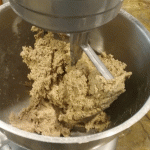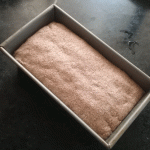| Rye %: | 82% |
| Stages: | Sponge, Scald, Final dough |
| Leaven: | Instant yeast |
| Start to Finish: | 10-12 hours |
| Hands-on Time: | 25-30 minutes |
| Yield: | One 2¼ lb./1.0 kg loaf |
Not so long ago, the food reporter from a South Carolina newspaper asked if I’d ever worked with Seashore rye. Actually, until that moment, I’d never even heard of it, but immediately went online and did some research. It turns out that this heirloom grain, which had been introduced into South Carolina, Georgia and northern Florida during the 1830s, was believed to be extinct. However, a food detective at Clemson University discovered a single stand of the grain on a family farm on Edisto Island, South Carolina, where it had been used for generations as windbreak between the tomato fields.
A newspaper article identified the farmer as Greg Johnsman, who also mills the rye and local varieties of heirloom corn, which he sells under the Geechie Boy Mill label. I immediately contacted Greg, who was kind enough to send me not only a load of his Seashore rye, but also several of his heirloom cornmeals.

This was and is an incredibly special grain. Its kernels are smaller and leaner than standard rye and have a golden brown color that’s very different from the gray-green I’m used to. But what was most striking was its incredible aroma: when I first opened the bag, I was overwhelmed with the sweet fragrance nf freshly cut hay – a perfume that lingered even after I milled the grain on my Kitchen Aid.
I thought it only appropriate to use this antique grain in a bread that reflected its history and provenance, and so I baked it into a recipe I adapted from The Dixie Cookbook, which was published in 1883.
Like many American rye breads, this one traces its culinary origins to the Rye and Indian breads of the earliest New England settlers, who brought rye with them to the New World and combined it with native corn. Unlike most New England versions, however, Dixie Rye doesn’t contain molasses and consists of 82% rye, versus the more usual 50%. I found the idea of reliving a moment in American culinary history – using traditional heirloom grains – truly exciting.
It was a trial-and-error exercise, since I’d had to translate the cups and spoons of the original recipes into weight measurements and verbal descriptions into times and temperatures. The first loaves I baked were way too dense, although the flavor was good, so I increased the water and made another pass. This time, it worked, and during the process, I discovered some meaningful differences between the Seashore rye and regular commercial rye. For one thing, the dough wasn’t as sticky, making it much easier to handle. At the same time, it wasn’t nearly as thirsty, so that even at 56% hydration (excluding the cornmeal scald), the dough was workable and the crumb tender.
The crumb was close and moist; the flavor was not what I was expecting: Seashore rye is very mild, without either the intense sweetness or spicy-bitter notes of commercial rye. However, its extraordinary perfume lingered and complemented the sweetness of the cornmeal, which, even at a mere 18% of total flour, came through, making this a highly distinctive bread that’s at its best with soups, stews, salads and smoked meats.
Note: Because the heirloom grains I used aren’t easy to come by, I’ve adjusted the water in the recipe below up from the 13.25 oz./375 ml I used for the heirloom grains to 15.85 oz./450 ml to compensate for commercial rye’s greater absorbency.
Sponge (Day 1, Evening):
| Ingredient | Grams | Ounces | Baker’s Percentage |
| Fine rye meal | 170 | 6.00 | 100% |
| Warm (105°F/41°C) water | 450 | 15.85 | 221% |
| Instant yeast | 4 | 0.15 | 2.35% |
Combine the sponge ingredients in the mixer bowl, cover and ferment at room temperature (70°F/21°C) until the sponge has expanded and become very bubbly, 8-10 hours or overnight.
Scald (Day 2, Morning):
| Ingredient | Grams | Ounces | Baker’s Percentage |
| Cornmeal | 120 | 4.25 | 100% |
| Boiling water | 120 | 4.25 | 100% |
In a separate bowl, combine the cornmeal and boiling water and mix until the cornmeal is evenly moistened. Cover and let stand at room temperature until cool, 30-40 minutes
Final Dough (Day 2, Morning):
| Ingredient | Grams | Ounces |
| Sponge | 549 | 19.40 |
| Scald | 240 | 8.50 |
| Whole rye flour | 375 | 13.25 |
| Salt | 12 | 0.40 |
Add the scald, whole rye flour and salt to the sponge and use the paddle at low (KA2) speed to mix until evenly blended into a firm dough that gathers around the paddle.
Turn the dough into a well-greased 9″x5″x3″/23x13x8 cm standard loaf pan and use wet hands and a plastic scraper to smooth the top.
Cover the loaf and proof at room temperature until it has expanded to within 1 inch/2.5cm of the rim of the pan, 60-70 minutes.
Preheat the oven to 450°F/230°C, brush the loaf with water and bake 10 minutes, then reduce to 350°F/175°C and continue baking until the loaf thumps when tapped with a finger and the internal temperature is at least 198°F/92°C, 40-45 minutes. Transfer to a rack and cool thoroughly before slicing.
Baker’s Percentages:
| Ingredient |
g |
% |
| TOTAL FLOUR |
665 |
100.00% |
| Fine rye meal |
170 |
25.56% |
| Whole rye flour |
375 |
56.39% |
| Cornmeal |
120 |
18.05% |
| Water |
570 |
85.71% |
| Salt |
12 |
1.80% |
| Instant yeast |
4 |
0.60% |
| TOTAL FORMULA |
1,081 |
162.56% |
| Flour prefermented |
170 |
25.56% |








clazar123
August 24, 2016Lovely, light-colored loaf. The crumb looks moist and dense but I’m curious if it became particularly crumbly after a day or two?
What a find for the food investigator! And how amazing that there were seeds growing continuously over all that time.
Thank you!
Stanley Ginsberg
August 24, 2016The loaf held itself together very nicely over the course of 4 or 5 days during which it was consumed. And yes, the discovery was quite serendipitous: because this particular variety of rye can grow up to 6 feet tall, it was ideally suited for windbreaks, and its survival was as much a matter of benign neglect on the farmers’ part as it was of the plant’s inherent hardiness.
Dabrownman
August 24, 2016It sounds and looks like a natural cross of rye and wheat if that were even possible. Another interesting grain for sure. Mixing it with corn mush takes us back to great, great, great granny. Nice bake and experiment Stan.
Dabrownmwn
Stanley Ginsberg
August 24, 2016William Rubel, founder of the FB group Bread History and Practice, added this footnote to my link:
“Seashore Rye” referenced in Stanley Ginsberg’s post is now included in the Slow Food Ark of Taste. It is a “black rye” first brought to the Carolinas in the 1830s. Its Ark of Taste name is Seashore Black Rye.
Besides the current references in relation to the Ark of Taste there are no internet, google book, or google scholar references to “seashore rye.” There are, however, many references to “black rye.” Period texts speak of “black” and “white” rye. In New York, at least, by the 1850s, black rye as a human food crop had been long replaced by other varieties. The period literature on black rye focuses on its use for forage, wind breaks, and other non-human consumption purposes.
The University of Florida has a breeding program for “black rye.” 50 pound (20kg) sacks of grain can be purchased for $50 from commercial seed sellers! It would certainly be interesting to compare “seashore rye” (which is not commercially available) with the University of Florida cultivars. Anyone up to testing out some black rye? http://hancockseed.com/fl-401-grain-rye-seed-50-lb-bag…
Bob Currier
September 2, 2016Dade City Fl, home of Hancock Seed is only 1 hour from where I live. I’ll be making the trip this weekend. Looking forward to experimenting milling in my Nutrimill and seeing how the flour performs.
Stanley Ginsberg
September 2, 2016Nice! Let us know how it turns out.
Stanley Ginsberg
August 25, 2016One more thought: Rye and wheat have been successfully hybridized into Triticale, so no reason that this couldn’t have happened spontaneously — except that the Deep South isn’t so much wheat country as it is rice and corn.
Bob Currier
September 10, 2016Temporarily held up by Hurricane Hermine passing close by the coast. Heading out to Hancock Seed today. 50lb of black rye seed here we come!
Sonja B
April 30, 2017Could I ask if you got a chance to try baking with the black rye, and if so, what breads you tested and how the rye fared in them?
Thank you!
Rich
July 11, 2018Any updates Bob?
Robert Currier
July 11, 2018Yes, an update… We did make it to Hancock and purchased 50lbs of black rye. This was the smallest amount they would sell. I’m still using the the last bit. It’s a very light rye — grinds up nicely in my NutriMill to a light tan.
It’s great for making rye starters — very responsive. I had major activity in just a couple of days. It bakes well. I find that I prefer mixing it in with some whole wheat (also put through my NutriMill) and a little bit of AP. I’ve tried it straight, and it’s nice, but I do think it does better as an ensemble player rather than as a solo act.
Sorry for the lack of pictures. I’ll try to dig some up and post them.
Rich
June 27, 2018I just called https://geechieboymill.com/ about the seashore rye and they will be milling in the next few weeks. It’s late June so if you are interested give them a call. No guarantees how long they will have it.
Rich
July 11, 2018BTW the link to the black rye has changed
https://hancockseed.com/fl-401-grain-rye-seed-50-lb-bag-121.html
NelAhmed
November 30, 2018I made this loaf using purple corn meal from “Against the Grain” here in Eastern Ontario.
It turned out beautifully, very dark blue, the taste is great.
Thank you.
Nel